Outdoor Use of LED Strip Lights: A Comprehensive Guide
Embracing Lighting: A Bright Look into LED Strip Lights
LED strip lights, also known as LED tape or ribbon lights, are flexible circuit boards populated by surface-mounted light-emitting diodes and other components. Usually available in reels, these strip lights can be cut to specific lengths, offering a great deal of flexibility in lighting design.
They are characterized by their high brightness and color versatility, providing a wide array of options for creative lighting solutions. These impressive attributes are complemented by their energy efficiency and prolonged lifespan compared to traditional lighting options.
The advent of LED strip lights represents a significant advancement in the world of lighting. Their versatile nature allows for a myriad of applications both indoors and outdoors, enabling users to instantly transform various spaces with captivating light patterns. From simple accent lighting to more intricate architectural installations or mood-setting solutions, the possibilities offered by LED strip lights are practically boundless.
The Sparkle in the Outdoors: A Discussion on Landscape Lighting with LEDs
Landscape lighting is an aspect where LED strip lights have found considerable use. With their ability to provide consistent lighting while consuming less power, they present an attractive option for highlighting outdoor features such as walkways, gardens, patios, or building outlines.
The term ‘landscape strip lights‘ has thus become synonymous with outdoor beautification projects aiming at enhancing aesthetic appeal after sunset. In the landscape lighting context specifically, application areas could include outlining pathways for safe navigation after dark or illuminating specific elements such as decks and patios during evening gatherings – all while adding an enchanting charm that traditional bulbs often fail to achieve.
A Guiding Light: Unveiling the Importance of this Discussion
As we delve deeper into this topic, it must be clarified why such a discussion holds relevance today. In our modern times, where sustainability is no longer just an ideal but a necessity and where aesthetic appeal and energy efficiency are being sought simultaneously, discussing the merits of LED strip lights for outdoor use becomes paramount.
We live in an era where lighting solutions are not just about functionality but also about making a statement with their design and environmental impact. The question is not if LED strip lights are good for outdoors, but rather, how we can maximize their potential to create efficient, sustainable, and visually appealing outdoor spaces.
By exploring this topic thoroughly, we aspire to provide valuable insights into the world of outdoor lighting design using LED strip lights – brightening paths towards a brighter future. In essence, our exploration aims to demonstrate that when it comes to landscape lighting or indeed any form of illumination challenge, LEDs have truly become the guiding light leading us into a new era of brightness.
Understanding LED Strip Lights: Lighting the Basics
The realm of lighting has been dramatically transformed with the advent of light-emitting diodes, or LEDs. Strip lights, where these tiny yet powerful light sources are arranged in a linear array, have gained substantial popularity. To understand why LED strip lights are an excellent choice for outdoor applications like landscape lighting or decking illumination, one must first comprehend what they are fundamentally.
Definition and Basic Components of LED Strip Lights: The Core of Lighting
LED strip lights can be succinctly defined as flexible circuit boards populated by surface-mounted light-emitting diodes (SMD LEDs) and other components that ensure their functionality. These strips take advantage of LEDs’ compactness and versatility, allowing them to be formed into various shapes. They provide a seamless line of bright, even light that traditional bulbs can’t achieve, making them ideal for accentuating architectural details or providing functional lighting.
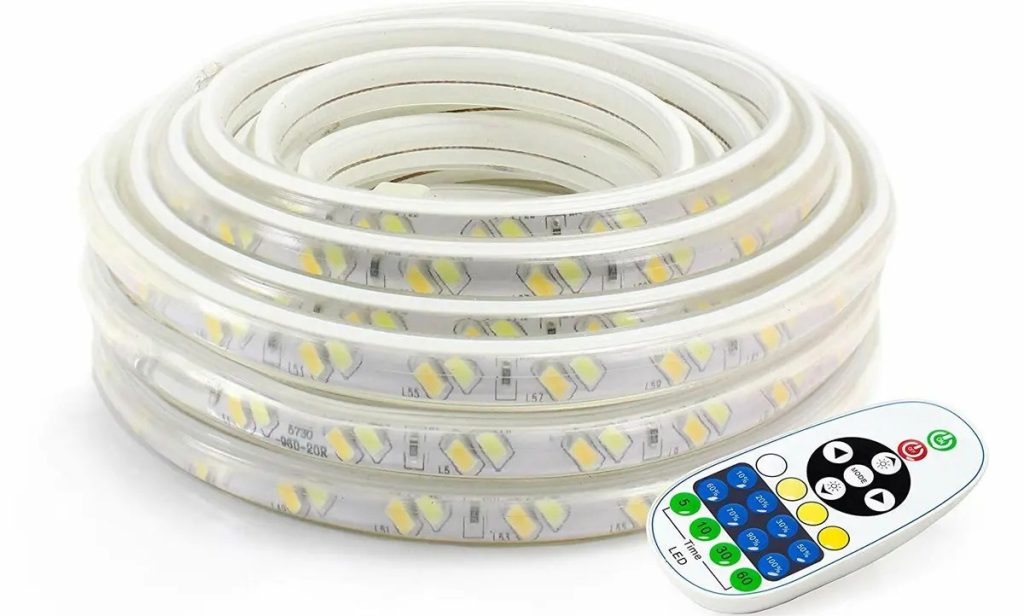
The basic components that make up an LED strip light include the LED chips themselves – tiny electronic devices that emit light when electricity is applied; resistors, which control the current flow to each chip; solder pads at either end for powering the strip; and finally, the flexible printed circuit board (PCB), which holds these parts together. The entire assembly is often coated in a protective silicone layer for enhanced durability and longevity – crucial elements when considering outdoor applications such as landscape strip lights.
LEDs use semiconductor technology wherein electricity interacts with certain materials to produce visible light – a process known as electroluminescence. This method renders LEDs significantly more energy-efficient than traditional incandescent bulbs, which generate light through heat-induced illumination.
Different Types of LED Strip Lights: Diversity in Luminosity
There’s an astonishing variety of LED strip lights available today, each designed with specific purposes in mind. For instance, single-color strips emit a fixed light color, with warm white, cool white, and daylight being popular choices for landscape lighting. They are straightforward to install and operate, often requiring just a simple power supply.
RGB LED strip lights are another type; they can emit red, green, and blue light independently or in combination to create a vast palette of colors. These strips come with controllers that allow users to customize color output – perfect for creating mood lighting during outdoor events or seasonal displays.
For an even more vivid color experience, there are RGBW strips that add a pure white LED chip to the usual trio. This addition offers better-quality whites than RGB strips alone can provide – a vital feature when accurate color representation matters.
Then we have high-density LED strip lights that pack more LEDs per foot (or meter) than standard strips. These offer brighter illumination and minimal spotting – ideal when bright landscape strip lights are needed.
Smart LED strip lights bring connectivity into the mix. They can be controlled via smartphone apps or integrated into smart home ecosystems for automation purposes – an excellent choice for those seeking modern convenience along with their outdoor lighting solutions.
Each type of LED strip light boasts unique features, making them suitable for various applications – be it simple pathway lighting or a stunning exterior design scheme. Understanding the technical aspects of these luminous wonders allows us to utilize them effectively in our outdoor spaces or anywhere needing superior lighting solutions.
Advantages of Using LED Strip Lights Outdoors
The Epitome of Energy Efficiency and Longevity
LED strip lights have emerged as a paragon of energy efficiency, trumping traditional incandescent and fluorescent lamps by leaps and bounds. They convert a staggering 90% of energy into light, contrary to conventional bulbs that squander the same amount as heat. Consequently, they consume less power while radiating the same or even higher levels of brightness, thus proving to be an economical choice for outdoor landscape strip lights.
One fascinating facet about LED strip lights is their impressively long lifespan. These luminous workhorses are engineered to glow unabatedly for approximately 50,000 hours before dimming gradually. In stark contrast with other lighting fixtures, which quit abruptly without warning, LEDs provide ample headway before requiring replacement. This longevity drastically reduces both direct costs involved in buying new sets and indirect costs associated with time and effort spent on replacements, making them ideal for landscape lighting.
A testimony to the durability of LEDs is their resilience against switching cycles. Unlike traditional counterparts that falter under frequent switching on and off, LEDs are immune to such adverse effects, furthering their lifespan advantage. The cumulative effect translates into substantial savings over time – an attribute every homeowner appreciates. The inherent coolness feature of LEDs results in an extended life span too.
Traditional lighting systems generate heat, which negatively impacts their longevity rates, whereas LED systems remain cool despite prolonged use, thus offering superior durability and rendering them perfect for sustainable outdoor lighting. Moreover, emitting less heat makes LED strip lights safer alternatives, particularly when children are present or in scenarios where the risk of accidental contact remains high, such as crowded parties or gatherings at home – another compelling reason advocating their outdoor use.
Unparalleled Flexibility in Design and Installation
Beyond energy efficiency and longevity, LED strip lights offer unmatched flexibility when it comes to design and installation. The thin, flexible strips can be cut to exact lengths and installed virtually anywhere, from the edge of a rooftop to winding garden paths, making them ideal landscape strip lights.
With adhesive backing available on most LED strips, the installation process boils down to peeling and sticking onto the desired surface. This ease of installation further extends to interconnecting multiple strips for extended lengths, allowing for seamless linear lighting along patios or driveways.
Due to their compact size and bendability, these lights can navigate corners with relative ease compared to traditional lighting fixtures, which are rigid. This flexibility opens up a plethora of creative possibilities in landscape lighting design, transforming ordinary spaces into visually spectacular environments.
LED strip lights also allow users control over lighting directionality. Unlike traditional circular light dispersion patterns, often resulting in wasted light energy, LEDs emit light linearly, focusing exactly where needed; an advantage that amplifies their role as outdoor illuminators.
Yet importantly is the added benefit of these lights being low-voltage systems. This makes LED strip lights incredibly safe for outdoor use even in wet conditions, assuming proper installation procedures are followed – a feature not commonly seen among household lighting solutions.
An Array of Color Options and Light Intensity
LED strip lights are not merely functional tools but also artistic instruments that imbue aesthetics into your environment. They come with a wide array of color options ranging from warm white hues perfect for serene evening settings on decks or patios to vibrant multicolored variants great for creating festive ambiances during celebrations.
A unique attribute of LED technology is its capacity for dynamic color mixing, offering endless spectrum possibilities. This ability makes the humble LED strip light an adept mood setter, responding effectively to varying aesthetic needs – whether it’s enhancing architectural features with specific colors or setting party moods with pulsating multi-color displays.
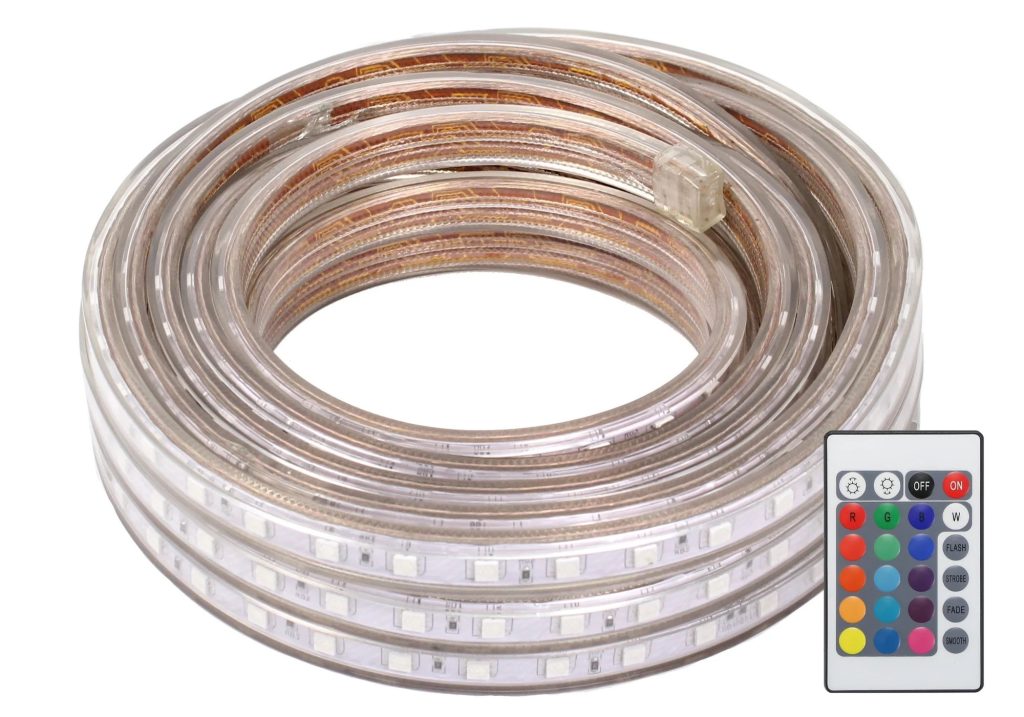
A key advantage lies in LEDs’ dimming capabilities, which conventional lights struggle with. With compatible accessories, LEDs can provide varying intensities of light at the flick of a switch or even through remote controls. This feature helps regulate the brightness level to suit specific needs and occasions.
Moreover, the color consistency across LED strip lights is commendable. Regardless of the length or number of strips used, you will observe a uniform color output without any discernible variations, which is often an issue with traditional lighting systems – a testament to their superior technology.
LED technology has revolutionized outdoor lighting with its energy efficiency, longevity, installation flexibility, and the vast range of color options it brings to your disposal. These features make LED strip lights an excellent choice for landscape lighting and other outdoor applications.
Factors to Consider when Choosing Outdoor LED Strip Lights
LED strip lights are increasingly becoming a pivotal component of outdoor landscape lighting. But, as with any investment, certain factors must be carefully contemplated to ensure it is suitable for your purpose and environment. Weather resistance, brightness level, and color temperature are particularly significant aspects that warrant consideration when choosing outdoor LED strip lights.
Navigating the Storm: Understanding IP Ratings
Firstly, weather resistance is a crucial factor due to the exposed nature of landscape strip lights. This aspect is often denoted by an ingress protection (IP) rating. An IP rating consists of two numbers representing protection against solid objects (including dust) and liquids, respectively.
A high first digit indicates robust protection against foreign bodies, whereas a high second digit denotes substantial water resistance – an essential attribute in combating diverse weather conditions or direct contact with irrigation systems in your garden. Therefore, when choosing outdoor LED strip lights for landscape lighting, it would be wise to consider options with higher IP ratings, such as IP65 or above, where full exposure to weather elements is expected.
The Luminary Puzzle: Lumens versus Watts
Brightness level is another significant facet that influences the efficacy of your LED strips in outdoor lighting. Traditionally, we have associated brightness with wattage. However, this concept has transformed with the advent of LEDs, where brightness is more accurately represented by lumens.
Lumens signify the total amount of visible light emitted by a source. Henceforth, a higher lumen count represents greater brightness. As opposed to watts, which measure power consumption, this becomes especially evocative considering that LEDs provide more light (lumens) using less power (watts) than their incandescent counterparts.
In outdoor settings, achieving the right brightness can be a delicate balance. Too much light can wash out the environment, making it stark and uninviting, while too little might not adequately illuminate your landscape lighting. Therefore, understanding lumens and choosing the right one for your LED strip lights is essential.
Setting the Mood: Warm versus Cool Light
The color temperature of your LED strip lights can greatly influence the ambience of your outdoor space. Color temperature is measured in Kelvin (K), with higher numbers corresponding to cool (blue/white) light and lower numbers indicating warm (yellow/orange) light.
When exploring landscape lighting ideas using LED strip lights, mindful selection of color temperature can truly make or break your desired aesthetic. Warm light tends to create a cozy, inviting atmosphere reminiscent of a campfire’s glow, making it an ideal choice for intimate spaces like decks or patios. On the other hand, cool light often appears brighter and more alerting, which might be better suited to areas requiring clear visibility such as driveways or walkways.
When selecting outdoor LED strip lights for landscape lighting applications, careful consideration must be given to their IP rating (weather resistance), lumens count (brightness level), and Kelvin number (color temperature). These factors collectively determine how well-suited a particular set of lights will be to enhancing the beauty and functionality of your outdoor spaces.
Specific Outdoor Applications of LED Strip Lights
Enlivening Landscapes: Gardens and Pathways
The allure of LED strip lights extends far beyond their aesthetic appeal. They are a multifaceted tool, often employed to transform ordinary outdoor spaces into luminescent havens. For instance, landscape strip lights can be applied to gardens and pathways to illuminate the natural beauty in the dark hours.
Strategically placed LED strip lights can highlight the vibrant colors and textures in your garden, creating a captivating nighttime panorama. LEDs can also be installed along garden paths for increased visibility during those nocturnal strolls or late evening social gatherings.
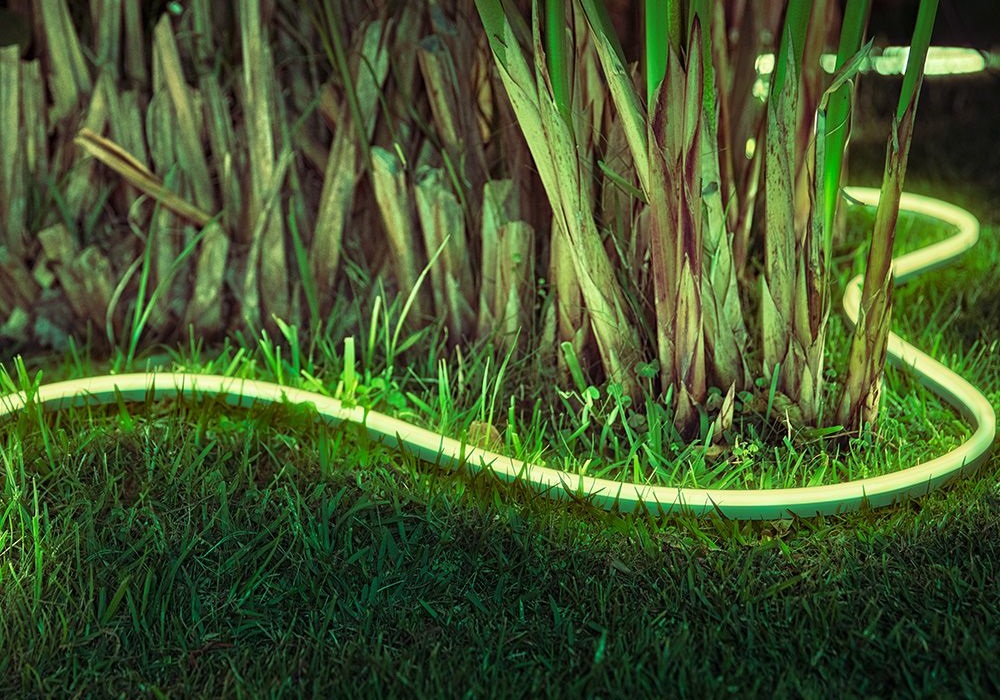
The brilliance of these landscape lighting fixtures significantly reduces the risk of accidental tripping over unseen obstacles while simultaneously adding a touch of elegance to your walkways. A notable feature about these innovative light sources is their versatility in design options.
Whether you prefer soft, warm tones that glow discreetly or vibrant hues that pop with color, LED strip lights offer a wide assortment that caters to individual preferences. Moreover, installing these landscape lighting fixtures not only enhances security but also elevates the overall aesthetic appeal.
By casting shadows and highlighting key features such as ponds or statues, they create intriguing visual effects that beckon further exploration. LED strip lights offer an environmentally friendly solution for landscape lighting needs by consuming less energy than traditional light sources while producing a higher lumen output.
Architectural Lighting: Outlining Buildings and Staircases
Architectural lighting has become an increasingly popular application for outdoor LED strip lights due to their flexible design and high-quality lighting capabilities. By outlining buildings with LEDs, businesses and homeowners are able to accentuate unique architectural features whilst creating an inviting ambiance after dusk.
Strip lights outlining staircases do more than just provide a well-lit path – they elegantly underscore every step with a soft glow, combining function and aesthetics in a simple yet profound way. This not only enhances safety but also adds a touch of sophistication to the exterior architecture.
The creative use of LED strip lights can bring out the depth and dimensions of a building facade. Whether installed as uplighting or downlighting fixtures, they can produce dramatic effects by enhancing textures, revealing forms, and creating intriguing patterns of light and shadow.
The durability and weather-resistant features of these LEDs make them an excellent choice for architectural lighting in outdoor environments. They can withstand harsh weather conditions while maintaining their brilliance throughout their extensive lifespan.
Energy efficiency is another significant advantage offered by LED strip lights. Their low power consumption combined with their longevity makes them an economical choice for highlighting architectural designs without the hefty energy bills associated with traditional lighting options.
Recreational Lighting: Patios, Decks, and Pools
LED strip lights have transformed recreational outdoor spaces into vibrant social hubs that continue to twinkle long after the Sun has set. Patios are no longer cloaked in darkness but radiate with warmth from meticulously positioned LED strip lights that create an inviting ambiance perfect for evening entertainments. Decks too have seen an aesthetic upgrade with these versatile light strips.
Whether used as under-rail lighting or integrated into steps for better visibility at night, these LEDs not only enhance safety but also accentuate the beauty of your deck during those late-night gatherings. For those lucky enough to have pools in their backyards, LED strip lights offer an impressive enhancement to your aquatic landscape.
By illuminating the pool perimeter or underwater surfaces, you can create a mesmerizing effect that makes midnight swims even more enticing. Moreover, because most high-quality outdoor LED strip lights are water-resistant (or even waterproof), they are incredibly safe around wet environments such as pool areas.
This added layer of security ensures peace of mind while providing efficient lighting for nighttime swimming or parties. Whether it’s sprucing up your garden, emphasizing architectural features, or enhancing recreational spaces, LED strip lights have proven to be a versatile and efficient choice for outdoor lighting needs.
The Art of Placement: Maximizing the Impact of Landscape Strip Lights
When installing outdoor LED strip lights, proper placement is key to achieving maximum effect. Like a well-directed stage play, landscape lighting should accentuate the most captivating features of your setting while also maintaining an overall atmosphere.
The first essential step is to identify the main elements you wish to highlight. These might include unique architectural structures, garden patches, or walkways. Upon identifying these focal points, consider how landscape strip lights can be used to create dramatic effects.
Side lighting can unveil textures on walls or trees, while uplighting could potentially dramatize shapes and silhouettes. Don’t forget about downward-facing lights, as these are excellent for illuminating paths, thus creating a safer and more enchanting environment.
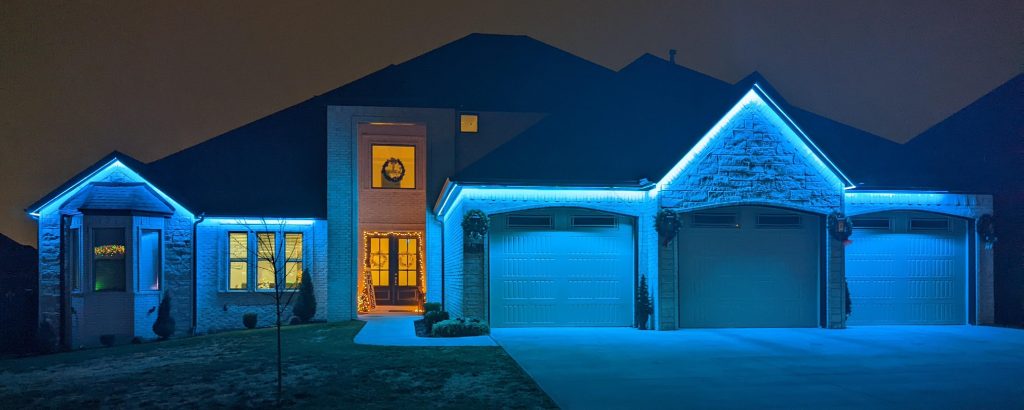
LED strip lights are flexible and easy to work with, making them ideal for contouring around different shapes – curving along pathways or wrapping around tree trunks, for instance. Consider lining your driveways or entrances with these lights, as they provide a warm welcome to guests while subtly showcasing your exterior design.
It is important not only to focus on the ground level but also to take into account higher levels such as steps, decks, or balconies when planning placement. A combination of low- and high-level lighting ensures balanced lighting that effectively showcases your entire landscape at night.
Remember that less can be more when it comes to lighting design. Avoid over-illumination by maintaining some darker areas, which will serve two purposes – enhancing contrast in the lit spots and preserving the natural charm of nighttime darkness in your surroundings.
Safety First: Ensuring a Risk-Free Installation Process
Safety during installation should never be overlooked when dealing with electricity-based items like LED strip lights. First off, ensure all power sources are turned off before starting the installation process. This preemptive step can prevent potential accidents.
Next, take note of all electrical codes and regulations in your locality. Compliance with these rules ensures a safe setup and can help bypass potential legal issues down the line. If you’re not well-versed in these codes or simply want to ensure professional quality, consider hiring a licensed electrician for the installation.
When securing strip lights, particularly those positioned high-up or in harder-to-reach areas, it is advisable to use sturdy ladders or scaffolding. This reduces the risk of falls during installation, which could lead to severe injuries.
Using waterproof LED strips is crucial when installing outdoor landscape lighting due to exposure to weather elements such as rain and snow. Verify that your lights have an appropriate IP rating, which indicates their resistance level against solid objects and moisture.
Always remember to inspect regularly for any signs of damage or wear on wires and extension cords. Timely replacement prevents electrical faults that could result in safety hazards.
Prolonging Brilliance: Sustaining Outdoor Landscape Lighting Over Time
Maintaining the longevity of your outdoor LED strip lights is a task that demands regular attention but yields rewarding results over time. The first rule of thumb here is periodic cleaning. Dust build-up can dull the brightness of your lights over time, while moisture can cause corrosion on metal parts, leading to eventual failure.
Cleaning should be done gently using a soft cloth or non-abrasive brushes so as not to damage delicate components, especially for silicone-coated LED strips, which are common for outdoor use due to their higher IP ratings. It’s also advised against using harsh cleaning chemicals, which might deteriorate housing materials faster than normal wear would.
For snow-laden areas, ensure you clear off heavy snow build-up on your lights frequently. The excess weight can strain the installations, causing damage or even complete breakage. Moreover, melting snow could potentially cause short circuits in less protected parts of the system.
Periodically inspect your LED strip lights for any signs of dimming or inconsistent brightness levels along the strip, which could be early indicators of failing LEDs. Address these issues promptly to prevent further deterioration that might lead to total failure.
Remember that while outdoor LED strip lights are built to last, they are not immortal. When their lifespan draws towards the end, make plans for replacements so that your beautiful outdoor landscape lighting remains uninterrupted.
Potential Challenges with Outdoor Use of LED Strip Lights
Exposure to Extreme Weather Conditions
While landscape strip lights are designed for outdoor use, their exposure to a wide range of weather conditions may pose certain challenges. For instance, excessive heat can impair the functionality of the LEDs and adversely affect their lifespan. The constant cycle of heating and cooling can cause wear on the materials used in LED strips over time.
Moreover, cold temperatures can also have a detrimental impact on LED strip lights. While LEDs themselves are impervious to cold conditions, the adhesive backing often used to affix these lights may lose its stickiness in frosty weather. Therefore, when it comes to landscape lighting during winter months, special consideration should be given to how these lights are installed.
Additionally, extreme weather conditions such as storms or heavy rainfall can potentially damage unprotected LED strip lights. While many models come with an ingress protection (IP) rating indicating their resistance against dust and water intrusion, persistent exposure to harsh elements might eventually compromise even the highest-rated strips.
Furthermore, UV rays from direct sunlight can cause fading or discoloration over time on the plastic components of an LED strip light. This is particularly true for low-quality products that do not come with UV-resistant coatings.
Landscape strip lights placed near coastal areas may face additional challenges due to saltwater corrosion. Even though they may be sealed against rain and snow penetration, few are designed to resist saltwater intrusion, which could cause early product failure.
Possible Electrical Issues
Beyond weather-related challenges lie potential electrical issues that could arise when using outdoor LED strip lights as part of your landscape lighting design. These concerns primarily stem from incorrect installation procedures or substandard products.
For example, cutting an LED strip improperly might result in a short circuit if wires touch each other unintentionally. This scenario not only will render your light strip ineffective but also can pose a fire hazard if left unchecked.
Another common issue involves voltage drop, which occurs when LED strip lights are run at lengths longer than their specified limit. The resulting inconsistency in brightness along the length of the strip detracts from the desired aesthetic effect and may reduce the overall lifespan of the product.
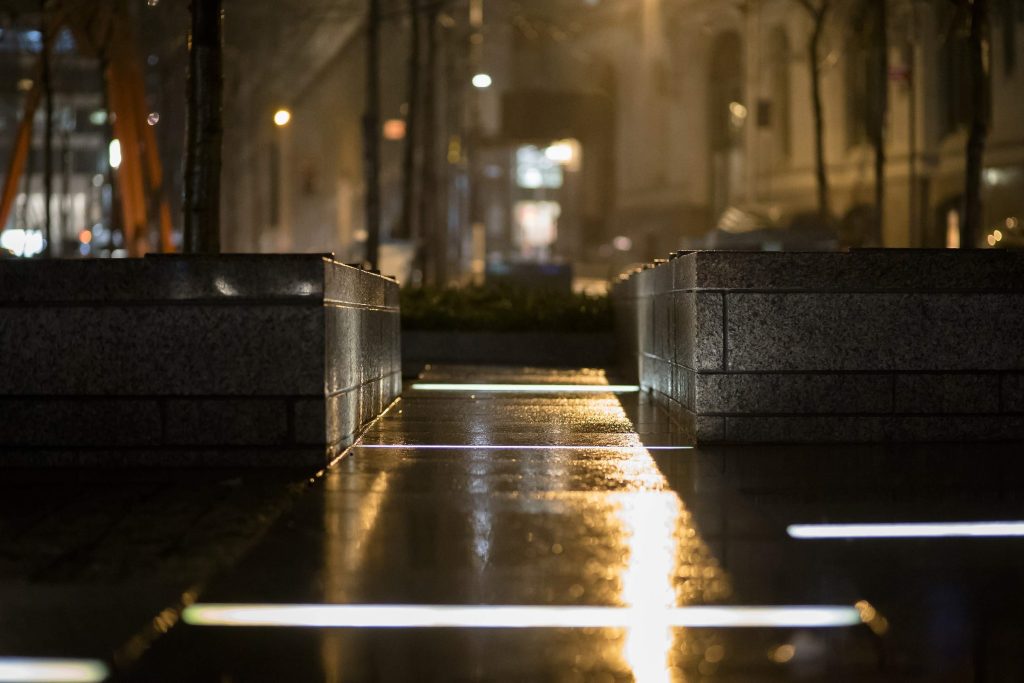
LED lights are also susceptible to power surges that could result from lightning strikes or fluctuation in your home’s electrical supply. Failure to use surge protectors or a power supply with enough buffering capacity could lead to catastrophic failures.
Additionally, choosing a landscape strip light product without proper certification may expose users to risk. Products without certified safety measures can overheat, causing not only damage to the lights themselves but potentially creating an electrical fire hazard.
Connecting too many LED strips together without considering their total power draw is another common mistake that can lead to overheating and potential damage. It’s crucial to calculate the total wattage of all connected strips and ensure they do not exceed the capacity of your power supply unit.
Case Studies showing Effective Use of Outdoor LED Strip Lights
A Glowing Residential Paradigm
In the realm of residential applications, LED strip lights have carved a distinct niche for themselves. One exemplary case is that of a contemporary house in Seattle, Washington. The homeowners utilized landscape lighting to accentuate the architectural features of their house and garden. Here, LED strip lights were tactically embedded into pathways and around foliage, striking an exquisite balance between functionality and aesthetics.
Moreover, another impressive illustration is a quaint bungalow in Boulder, Colorado. The residents chose to install landscape strip lights around their patio area to create an inviting outdoor living space. Besides offering an enchanting ambiance for evening entertainment, these lights significantly enhanced visibility, ensuring safety for all family members.
Traveling eastward across the Atlantic, we find an idyllic country cottage in rural England that ingeniously employs LED strip lights. In this case study, warm-toned LEDs were intertwined with climbing ivy on a garden trellis, creating an ethereal glow – making it seem as though magic had been infused into the landscape lighting.
Notably also is a villa along the shores of Cannes in France where the underwater pool uses color-changing LED strip lights. These lights not only contribute to creating visually appealing nighttime swims but also serve as safety aids indicating water depth variations.
Enlightened Commercial Endeavors
On the commercial front too, business establishments have harvested substantial benefits from using outdoor LED strip lighting solutions. Consider, for instance, Sydney’s iconic Opera House, which employs these lights to outline its unique silhouette during nighttime, thereby augmenting its landmark status.
Moving closer to home within United States boundaries lies Times Square in New York City, famously known as ‘The Crossroads of the World’. Here digital billboards and neon signs are often reinforced with strategically placed LED strips, enhancing readability and visual impact.
In Las Vegas too, the city that arguably could be considered the epicenter of commercial lighting, many casinos and entertainment venues have integrated LED strip lights into their architecture. They utilize them to create stunning visual patterns and displays to attract visitors and provide an all-encompassing sensory experience.
Another noteworthy example is a chain of outdoor shopping centers in California. Landscape strip lights have been used here to illuminate walking paths, accentuate signage, and highlight architectural details – making these centers safe yet aesthetically pleasing hubs for shoppers during night hours.
Globally recognized theme parks like Disneyland and Universal Studios also incorporate LED strip lights in various capacities. Whether it’s lighting up the castle at Magic Kingdom or creating enchanting light parades, these commercial spaces are testament to the versatility and efficiency of LED strip lights in outdoor applications.
Comparing Other Lighting Options with Outdoor LED Strip Lights
The Classic Contender: Traditional Incandescent Bulbs
The rich, warm glow of incandescent bulbs has long been a staple in landscape lighting. However, they are far from the ideal choice when it comes to outdoor applications. The primary disadvantage of these bulbs is their inefficiency. An incandescent bulb expends approximately 90% of its energy as heat rather than light – a significant shortcoming when compared to LED strip lights’ impressive energy efficiency.
Furthermore, the longevity of incandescent bulbs pales in comparison to LED strip lights. They typically burn out after about 1,000 hours – a stark contrast to LEDs that can last up to 50,000 hours or more. The need for frequent replacements not only makes incandescent landscape strip lights more labor-intensive but also contributes to greater environmental waste.
From a design perspective, traditional bulbs lack the versatility and customization offered by LED strip lights. LEDs offer a myriad of color choices and brightness levels – attributes that are key considerations in landscape lighting designs. Traditional incandescent bulbs tend to be fragile and sensitive to weather conditions – an issue that is significantly mitigated with weather-resistant outdoor LED strip lights.
Sun-Power Solution: Solar-Powered Lights
Another popular alternative for outdoor lighting is solar-powered lights – a solution seemingly perfect for an age increasingly conscious about sustainability and renewable energy sources. However, despite their eco-friendly reputation, they aren’t without drawbacks when compared against outdoor LED strip lights.
One crucial factor limiting solar-powered landscape lighting options is their dependence on sunlight for power generation. On cloudy days or during winters with shorter daylight hours, these light fixtures’ performance might be compromised – resulting in weaker or inconsistent lighting levels. Solar-powered landscape strip lights also typically have lower brightness output compared to electrical-grid LED counterparts – an important consideration if the aim is to illuminate large outdoor spaces effectively.
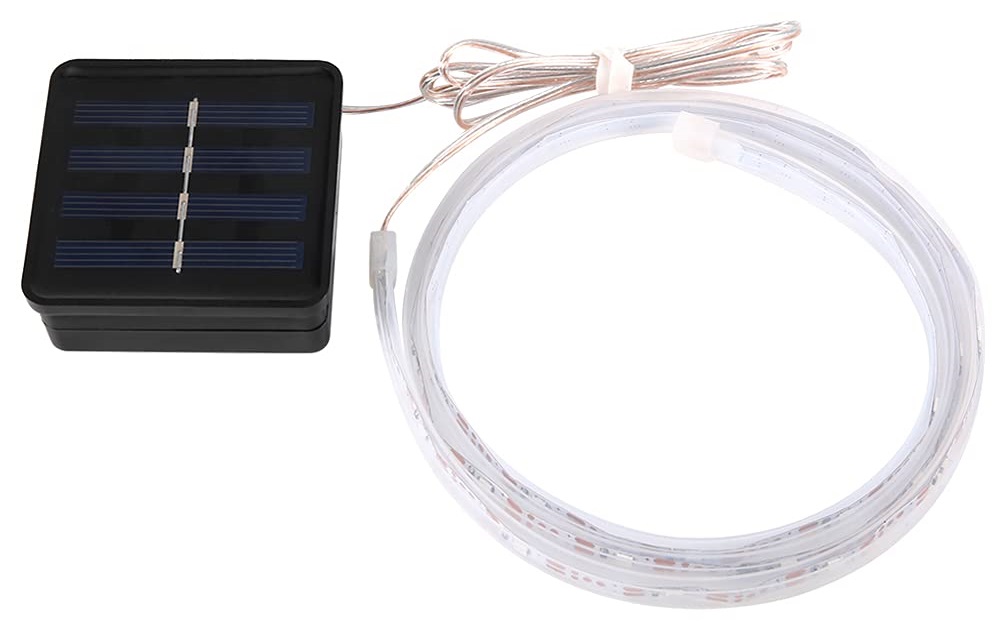
Moreover, while solar-powered lights do offer some level of design flexibility, they typically don’t match the breadth and depth of customizable options offered by LED strip lighting. Whether it’s adjusting brightness levels, changing colors, or shaping the strip to fit specific architectural features – LEDs offer more creative freedom.
In terms of longevity, solar lights tend to have shorter lifespans due to the wear and tear on their batteries from daily charging and discharging cycles. When compared with LED strip lights’ impressive lifespan – a clear advantage emerges for LEDs in this aspect.
To conclude, both traditional incandescent bulbs and solar-powered landscape lighting have their unique strengths. Still, when pitted against the versatility, efficiency, durability, and design flexibility of outdoor LED strip lights, the latter seems like a more appealing choice for most landscaping needs.
The Radiance Recapitulated: Understanding the Pros and Cons
Embarking on the luminous journey through the realm of LED strip lights, we have unveiled a plethora of benefits that position these lights as an exemplary choice for outdoor use. These advantages include their remarkable energy efficiency and longevity – attributes that not only make them an eco-friendly lighting solution but also a cost-effective one in the long run.
The flexibility in design and installation broadens their applicability, making them suitable for outlining buildings or accentuating landscape details with landscape strip lights. Moreover, with their wide range of colors and adjustable light intensity, LED strip lights offer unparalleled versatility. The ability to customize these features allows homeowners and businesses to create the desired aesthetic or ambiance.
Whether lighting a garden pathway or emphasizing architectural structures, LED strip lights take landscape lighting to new heights. However, like any chosen path illuminated by our decisions, this one is not without potential challenges.
Outdoor use of LED strip lights necessitates careful consideration of factors such as weather resistance – particularly in areas prone to extreme weather conditions – and possible electrical issues that may arise over time. Moreover, although LED strip lights are generally designed for longevity, exposure to continual harsh conditions might affect their durability.
It is also essential to remember that while these lights offer significant advantages over traditional incandescent bulbs or solar-powered alternatives concerning brightness levels and design flexibility, they may require more initial financial investment. Proper maintenance is crucial in ensuring the continued optimal performance of these lighting solutions despite their built-in resilience against common issues faced by other light types.
Conclusion: Are LED Strip Lights Good for Outdoor Use?
When assessing the suitability of LED strip lights for outdoor application, it’s evident that these innovative devices possess considerable potential to brighten both residential and commercial exteriors. Their energy-saving attributes, coupled with their superior longevity and design versatility, make them a smart choice for landscape strip lights.
Whether it’s adding a warm glow to a garden pathway or creating a vibrant color show on building outlines, LED strip lights undeniably enhance the visual appeal of outdoor spaces. The variety of applications they offer demonstrates their adaptability and versatility – from accentuating architectural elements to providing recreational lighting for patios or pools.
However, it is essential to remember that, as with any electrical installation, safety considerations must be made paramount. A professional electrician can ensure that all installations are up to code and safe for prolonged outdoor use.
Moreover, as we touched upon earlier, potential challenges may arise with prolonged exposure to extreme weather conditions or electrical issues. Regular maintenance will be necessary to ensure the continued efficacy of these lights and prevent unnecessary replacements or repairs.
While LED strip lights are not without their challenges when used outdoors, these can largely be mitigated through informed selection based on factors like weather resistance ratings and proper installation methods. Armed with this knowledge, one can confidently embrace LED strip lights as an effective solution for enhancing landscape lighting in various outdoor settings.
References
Credible Sources to Light the Path
Throughout this exploration of the benefits, applications, challenges, and best practices associated with the use of LED strip lights in outdoor settings, various reputable sources have been consulted. These sources provide a plethora of knowledge based on scientific research, industry expertise, and practical experience that further solidifies our discussion around landscape lighting.
Our first source is “Light Emitting Diodes (LEDs)” by the US Department of Energy. This comprehensive documentation provides an extensive overview of LEDs, including their functionality, energy efficiency benefits, and different applications such as landscape strip lights.
The second reference point is a book titled “Introduction to Light-Emitting Diode Technology and Applications” by Gilbert Held. This publication delves deep into not just the technology behind LEDs but also its diverse uses in modern settings, which greatly contributed to our discussion on architectural and landscape lighting.
Next up is an informative article from The Spruce titled “How to Choose Outdoor Lighting: Your Guide to Landscape Lighting”. This piece offers a wealth of practical advice for homeowners looking to enhance their exterior spaces with strategic lighting. It was particularly relevant in guiding our section on installation tips for outdoor LED strip lights.
Shining More Light
For a global perspective on the topic, we referred to “The LED Advantage: Towards Beautiful and Sustainable Cities” by Philips Lighting. This whitepaper discusses the broader impacts of transitioning urban infrastructure towards LED lighting solutions – providing valuable insights into potential commercial uses for LED strip lights outdoors.
We tapped into expertise from IP rating specialists through an article titled “Understanding IP Ratings” provided by Ingress Protection Rating Specialists (IPRS). Their detailed explanation was instrumental in understanding how weather resistance applies to outdoor LED strip lights.
These references offer only a glimpse into the vast body of knowledge available about landscape lighting and LEDs in particular. Further reading would undoubtedly yield even more nuanced understanding, and we encourage all our readers to delve deeper into this interesting topic.
You may also be interested in the following posts:
